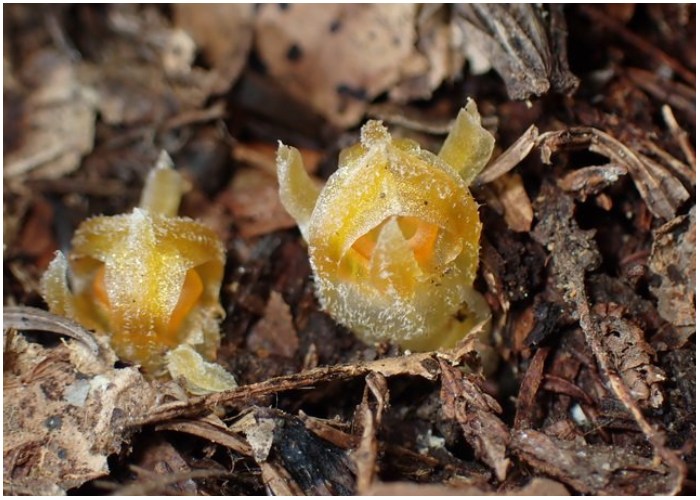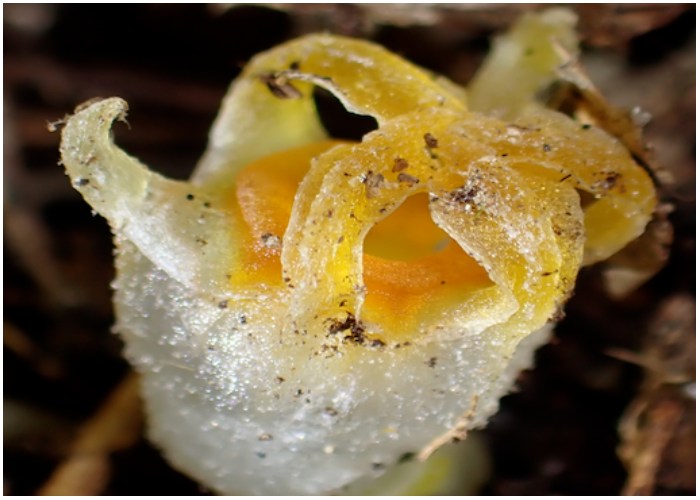In the fascinating world of chlorophyll-free “fairy lantern” plants, there is a new species to marvel at. Thismia malayana, recently discovered in the dense Malaysian rainforest, is a striking addition to the mysterious and parasitic herb family known for their peculiar, alien-like appearance. Fairy lanterns (Thismia) are renowned for their vibrant, psychedelic flowers, which lure in fungus gnats and other insects for pollination. The discovery of this new species highlights the rich biodiversity of Malaysia’s tropical forests and adds to the growing catalog of these elusive plants.
Unveiling Thismia malayana
The newly described Thismia malayana stands out with its bright yellow flowers encircled by brownish tentacle-like structures. These unique features, along with the orange-striped slug-shaped base and the thin, pale stem, make it an extraordinary sight. This plant, like its relatives, lacks chlorophyll and does not undergo photosynthesis. Instead, it siphons nutrients from underground fungi in a symbiotic relationship with more conventional plants. Typically found in mature tropical forests, fairy lanterns spend most of their lives underground, only briefly emerging to flower. This ephemeral appearance contributes to their elusive nature, making each discovery a significant botanical event.

The Quest for Discovery
Botanist Mat Yunoh Siti-Munirah of the Forest Research Institute Malaysia has been at the forefront of cataloging these parasitic plants. In 2020, an unusual fairy lantern was spotted in the Tengku Hassanal Wildlife Reserve, prompting further exploration. Siti-Munirah and her colleagues conducted rigorous fieldwork to locate and identify these plants. The search for Thismia is notoriously challenging; it requires precise timing and location to find the plants when they emerge from the soil. Despite these difficulties, the team succeeded in confirming the presence of a new species, which they named Thismia malayana. This discovery is particularly significant given that only a few individual plants were found, underscoring the rarity and vulnerability of the species.
Conservation Concerns
Thismia malayana’s discovery comes with a call for conservation. Siti-Munirah and her team have proposed that the species be considered vulnerable to extinction. Although the locations where it has been found are relatively protected, the small number of plants and their subterranean lifestyle complicate efforts to ensure their survival. The rarity of these plants, combined with their specialized habitat requirements, makes conservation a priority. Understanding the environmental conditions that support T. malayana could be crucial for developing effective conservation strategies and preserving this unique component of Malaysia’s biodiversity.

A Broader Perspective on Fairy Lanterns
Fairy lanterns are a diverse group of about 100 known species found across tropical South America, Asia, and Australia. Their sporadic appearances and specialized habitats have historically made them difficult to study. However, recent advances in genetic analysis and concerted efforts to explore understudied regions have led to the identification of multiple new species. Notable discoveries include the violet-tendrilled T. paradisiaca in Colombia and the pale, periscopic T. belumensis in Malaysia. Some species, like the dramatic T. neptunis of Borneo, have been rediscovered after being presumed extinct for decades.
The ongoing discovery and rediscovery of fairy lanterns reflect a growing interest in understanding these unique plants. Researchers like Siti-Munirah and Kenji Suetsugu of Kobe University in Japan emphasize the importance of studying the environmental conditions that support these plants. Such knowledge could be instrumental in conservation efforts, ensuring that these remarkable plants continue to intrigue and inspire future generations.
Conclusion
The unveiling of Thismia malayana is a testament to the wonders still hidden in the world’s tropical forests. As botanical exploration continues, each new discovery brings us closer to understanding the intricate web of life that sustains our planet. The fairy lanterns, with their otherworldly beauty and mysterious lifestyles, remind us of the endless marvels awaiting discovery in nature’s vast, unexplored realms. This journey of discovery not only enriches our scientific knowledge but also deepens our appreciation for the delicate and interconnected ecosystems that make up our world. Each new finding underscores the impor